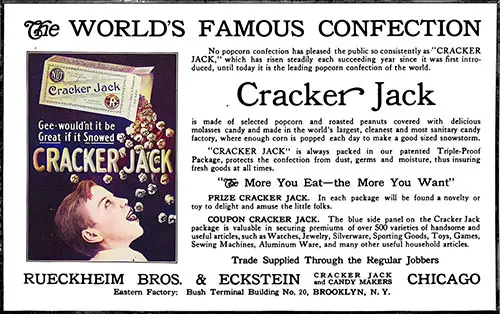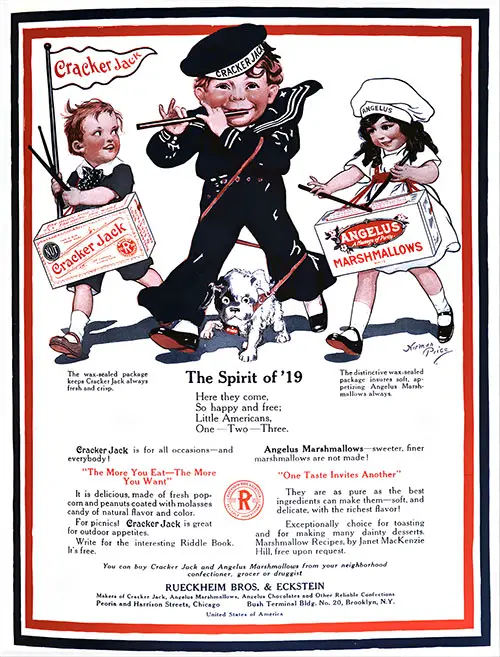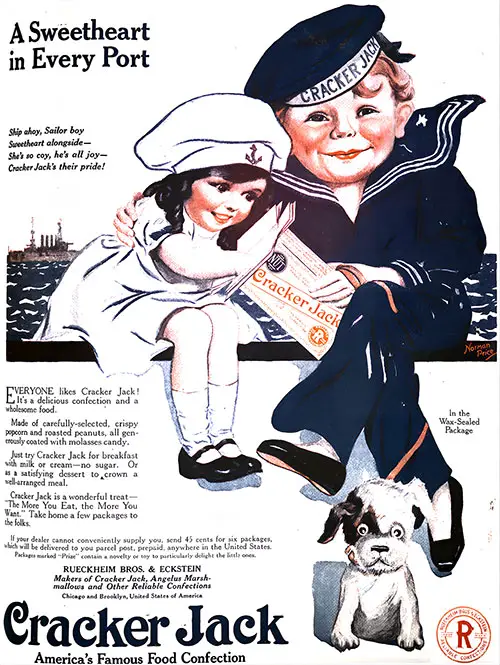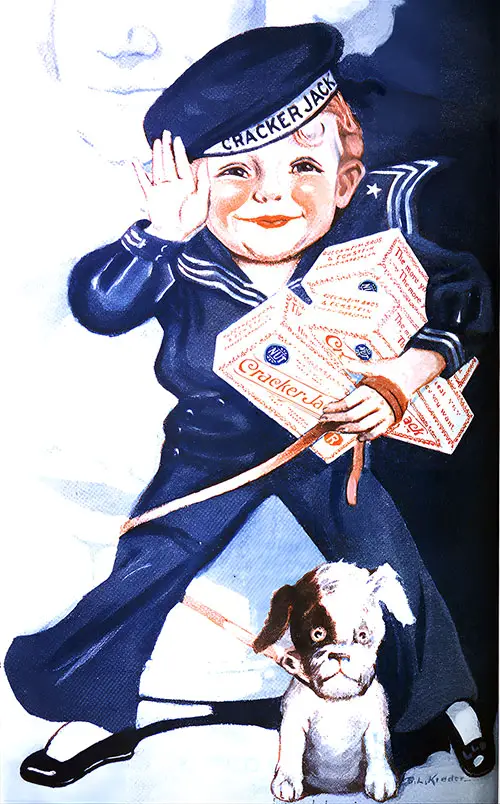Cracker Jack: The Sweet Story of America’s Popcorn Pioneer and the Birth of Snack Culture
📌 Explore the fascinating history of Cracker Jack, America’s iconic popcorn confection. From the 1893 World’s Fair to its advertising brilliance with Sailor Jack & Bingo, this 1915 article reveals how packaging, marketing, and nostalgia shaped one of the world’s most beloved snacks.

Cracker Jack - The World's Famous Confection Vintage Ad, 1915, (Candy and Ice Cream, February 1915) | GGA Image ID # 10284cc245
🎪🍯 Cracker Jack: The Popcorn Confection That Popped into American Hearts
📝 Review & Relevance
“The Story of Cracker Jack – 1915” is more than a tale of candy-coated popcorn and peanuts—it's a snapshot of American consumer culture, early advertising genius, and evolving tastes at the dawn of the 20th century. This vintage article explores how Cracker Jack went from a humble World's Fair snack to a household staple with global appeal.
For epicureans, it offers insight into the origins of one of the most iconic American confections. For educators and students, it’s a golden nugget for lessons in food marketing, packaging innovation, brand identity, and even sociocultural change. And for foodies? Well—it’s a delectable journey through flavor history that reminds us just how much storytelling sweetens every bite. 🍬🎓
Perhaps the best-known version of popcorn is Cracker Jack, a big hit at the 1893 Chicago World's Fair. The creator of this confection, F.W. Rueckheim, a German immigrant, hadn't given his product a name; he scooped the molasses-coated popcorn and peanut. The story varies, but in 1896 a salesman tasted the delicacy, smacked his lips, and announced, "Now that's a crackerjack!"
How Cracker Jack Came to Follow the Circus into Town
A Story of Twenty-five Years of Continuous Advertising
Let's rewind to the birth of Cracker Jack, a product that boldly stepped into the market long before the era of packaged goods. Advertising was just taking its first steps, and a packaged confection at an affordable price was a novelty. Cracker Jack seized the opportunity when competition was scarce, and the public was craving for such a wholesome treat. This was the year 1896.
Unfortunately, the product's character meant that it absorbed moisture from the air easily and deteriorated quickly. The radius of possible distribution was necessarily limited.
When Henry G. Eckstein joined the organization in 1898, he brought with him a brilliant and inventive mind, ready to tackle the challenge at hand.
First, an inner waxed carton was invented. After being filled with Cracker Jack, it was subsequently enclosed in an outer or printed carton. Later, a wax-sealed wrapper of flexible paper was devised, which could enfold the waxed carton, be sealed at the ends, and render the inner carton and the product impervious and commercially moisture-proof.
That was the start of Cracker Jack's general distribution. Immediately, it became possible to ship this perishable product across the continent and market it in substantially as crisp and delicious a state as when it left the mixing machines in the factory kitchens.
It took hold everywhere. Craker Jack established distribution immediately with jobbers, and sales jumped enormously.
Right and left, Cracker Jack began to blossom, many of them packaged. Though temporarily oversold, the heads of the organization realized that the day would come when all of these products would go into direct competition—and we began to lay their plans for the battle royal, a term used to describe fierce and decisive competition. It was simply an application of the lessons of the war to business—the determination to keep up the morale of the fighting force.
Morale is not just a battle term; it's equally crucial in business. When everyone in the organization, from factory workers to salespeople, jobbers, and dealers, knows that the leadership team has unwavering faith in the product's quality and the soundness of their policies, it sparks a wave of enthusiasm that energizes the entire operation.
Printers’ Ink – April 7, 1921

Advertisement: Rueckheim Bros. & Eckstein, 1919. (Confectioners' Journal, July 1919) | GGA Image ID # 10289e6f1a
CRACKER JACK is a sailor boy who has a sweetheart in every port. His sister ANGELUS is tagging along with him, selling marshmallows in every town where he distributes CRACKER JACK.
"The more you eat, the more you want," says Jack. And he keeps appearing regularly with his cute little pup Bingo. As every sailor knows, "Out of sight is out of mind !"
Before the wave of confectionery advertising that swept through all mediums, Cracker Jack personified a sailor boy, and his teammate, little Miss Angelus, took an important position.
Cracker Jack has always been a favorite of young people. Therefore, it was logical that the trade character we created should be a boy, jovial and happy, with his arm full of three packages of his favorite.
It is a trade character designed to appeal to children, to work its way into their memory and make friends of them. And because every boy should have his dog for a pal, we gave the Cracker Jack boy his Bingo—a hybrid pup of questionable pedigree, but just the sort that every boy loves.
A year later, the Cracker Jack Boy and his dog were introduced to the youngsters of America through magazines, cutouts, and window displays. Finally, regarding the package itself, we determined, utilizing a prize contest, how interested the children were in the trade character—incidentally, to decide whether or not they were reading our advertisements.
Over 60,000 different jingles were received. More than 18,000 boys and girls, sixteen years of age or under by the terms of the contest, matched poetic wits in an endeavor to capture the prizes.
There were jingles from every State in the Union, every province of Canada, every United States possession, and England, Italy, and even China.
The best part, from our standpoint, was the familiarity that all of the contestants showed with our previous advertising. We knew the Cracker Jack boy, his dog Bingo, the selling points of Cracker Jack, and the package—some of them mentioned selling arguments in their jingles that had not appeared in our advertising for three months previously.
It was a most inspiring contest, proof that we were pursuing a good strategy that needed no further vindication.

Advertisement: Cracker Jack "A Sweetheart in Every Port," 1919. (The Saturday Evening Post, 18 January 1919) | GGA Image ID # 1028b0fc38
Everyone likes Cracker Jack! It's a delicious confection and wholesome food. Made of carefully-selected, crispy popcorn and roasted peanuts, all generously coated with molasses candy.
Cracker Jack is a fantastic treat —"The More You Eat, the More You Want." Try Cracker Jack for breakfast with milk or cream–no sugar. Or as a satisfying dessert to crown a well-arranged meal. Take home a few packages to the folks.
There have been many exciting by-products of our advertising campaign, one of which is the influence it has had upon parents in permitting their children to buy Cracker Jack in preference to other sweeter confections.
From the first, they have stressed Cracker Jack's food value and satisfaction with the hunger for sweets. And again, in thousands upon thousands of cases, they have rejuvenated fathers and mothers and carried them back to their Cracker Jack hunger of other years.
Such are the publicity by-products of our campaign, which have kept Cracker Jack in a dominating position through one of the most turbulent markets and merchandising periods of all history.

Advertisement: Cracker Jack Sailor Blue, 1919. (The Saturday Evening Post, 22 February 1919) | GGA Image ID # 1029149ea0
Cracker Jack, America's Famous Food Confection, is made of the choicest popcorn, roasted peanuts, and delicious molasses candy to form a satisfying confection and wholesome food. It is delicious as an after-dinner sweet or at breakfast with milk or cream- no sugar. Give freely to the children for "between-meal" lunches and serve at parties.
Cracker Jack Manufacturer Changes Name
The confectionery manufacturing firm Rueckheim Bros. & Eckstein, Inc., of Chicago and Brooklyn, has dropped all personalities from its corporate name and will henceforth be known as the Cracker Jack Company in honor of its principal product.
The change, announced on the occasion of the company's fiftieth anniversary, was made after discovering that only an infinitesimal percentage of the people who bought and ate Cracker Jack had any idea who made it, and they did not care.
Therefore, as something having real advertising value that could be capitalized upon in the merchandising of other confections, the name Rueckheim Bros. & Eckstein had practically no significance or value. On the other hand, there was Cracker Jack, which had been so universally popularized through long years of consistent advertising that it had come to be regarded as a generic term.
After considering the matter many times, the board of directors finally decided the company should bear the name by which it was known best. The two principal considerations were the dropping of a cumbersome firm name that was hard to remember and the utilization of another name that would bring real advertising significance to any item to which it was attached.
Bibliography
F. E. Ruhling, "How Cracker Jack Came to Follow the Circus into Town: A Story of Twenty-five Years of Continuous Advertising," in Printers' Ink, 7 April 1921, p. 76, 81-82.
F. E. Ruhling was the General Sales Manager, Rueckheim Bros. & Eckstein, Chicago.
Cracker Jack Advertisements: Candy and Ice Cream (Feb 1915); Confectioners' Journal (Jul 1919); and The Saturday Evening Post (Jan 18, 1919 and Feb 22, 1919).
🎯 Most Engaging Highlights
🍿 Origins at the 1893 World's Fair
The article begins with the invention of Cracker Jack by German immigrant F.W. Rueckheim—popcorn, peanuts, and molasses mixed into magic. The name? Coined by a salesman who exclaimed, “Now that’s a crackerjack!” — a phrase meaning "top-notch" in turn-of-the-century slang.
📦 Moisture-Proof Packaging: A Revolutionary Leap
Henry Eckstein’s invention of triple-layer moisture-proof packaging in 1898 was a turning point. It turned Cracker Jack from a local treat into a national product with preserved freshness—opening the door to long-distance distribution, including on trains, ships, and at overseas military bases.
💡 Teachers: This is a prime example of how packaging technology intersects with business history and consumer behavior.
🎭 The Birth of the Cracker Jack Boy & Bingo
What’s a brand without a mascot? Enter Sailor Jack and Bingo, introduced to engage young audiences and fuel national advertising campaigns. These mascots, along with cutouts, posters, and contests, made Cracker Jack one of the earliest brands to create emotional loyalty through storytelling.
One contest even generated 60,000 jingles from kids across the U.S., Canada, England, Italy—even China! 📬✍️
🖼️ Noteworthy Vintage Advertisements (Image Highlights)
📸 Cracker Jack "A Sweetheart in Every Port" (1919) | Image ID: 1028b0fc38
A whimsical play on the sailor theme, this ad linked Cracker Jack to global romance and nostalgia, appealing to children and veterans alike. 🥹🌊
📸 Rueckheim Bros. Ad (1919) | Image ID: 10289e6f1a
This ad captures the rise of Cracker Jack as a lifestyle brand, not just a treat. It personifies the treat through Jack and Angelus, with storytelling embedded in every campaign.
📸 Sailor Blue Advertisement (1919) | Image ID: 1029149ea0
A compelling push to rebrand Cracker Jack as more than a candy—a “wholesome food,” suitable for breakfast with milk or as a dessert. This shift in product positioning is key for food marketers to study.
🧠 Educational Takeaways for the Classroom & Beyond
🧪 Science of Packaging: Waxed inner cartons and moisture barriers—this is food preservation before refrigeration.
📈 Advertising Strategy: From contests to mascots, the campaign illustrates principles still used by modern brands.
🌎 Global Reach: Cracker Jack jingles and advertising reached across continents, making it an early example of transnational food branding.
🍽️ Final Thoughts for Epicureans & Food Historians
Cracker Jack isn’t just a treat—it’s a cultural time capsule. It reveals how taste, memory, and marketing are tightly woven together in the American palate. The product’s evolution from hand-scooped novelty to mass-market legend reflects larger trends in industrialization, branding, and childhood consumerism. 🌍📦
📚 Students and food history buffs should consider using GG Archives' Cracker Jack materials as source material for essays on:
- The rise of branded food
- Early 20th-century advertising
- Packaging technology
- Confections and social class
